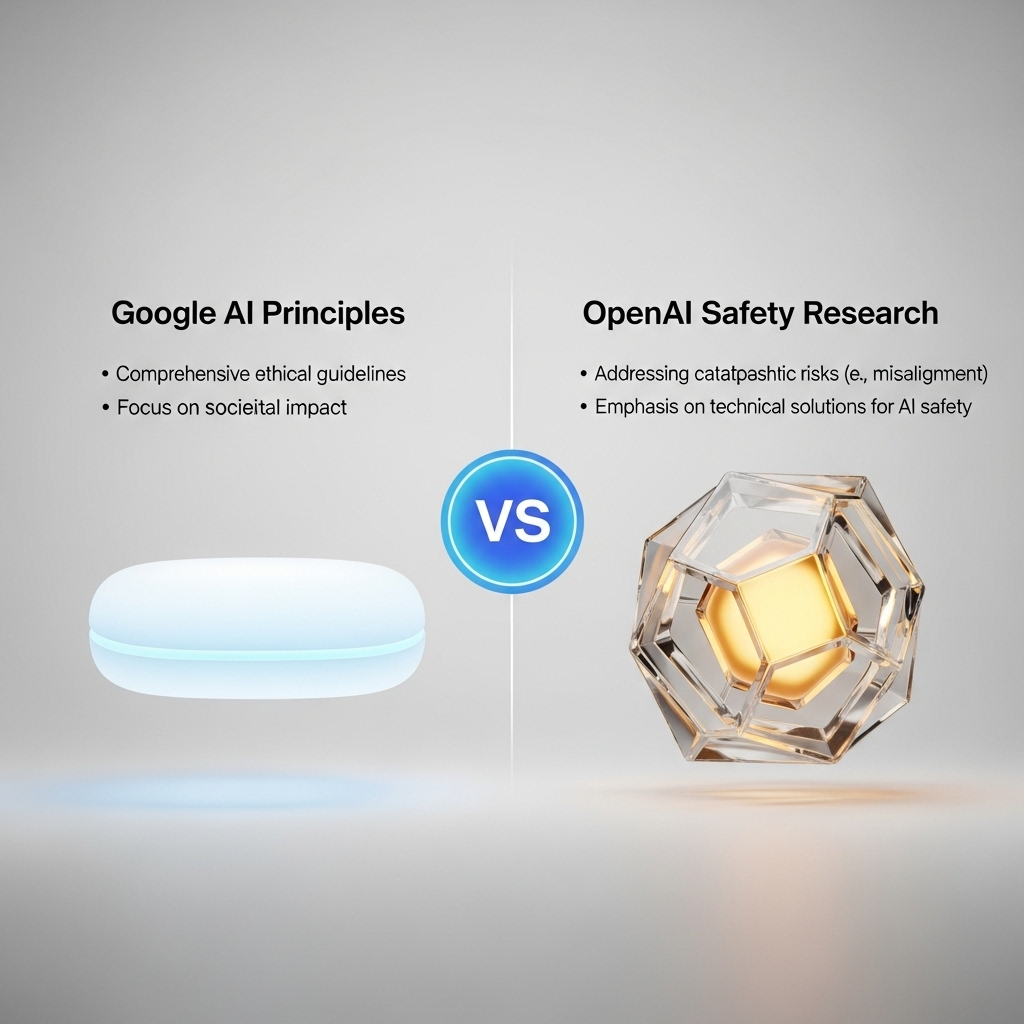Ai ethics programs > Google AI Principles vs. OpenAI Safety Research
In the rapidly evolving landscape of artificial intelligence, ethical considerations are paramount. Comparing Google's AI Principles and OpenAI's Safety Research reveals different approaches to ensuring responsible AI development and deployment, highlighting their respective strengths and weaknesses.
This comparison analyzes real-world performance, user feedback, and key differentiators to help you make an informed decision.
Quick Verdict
Both Google and OpenAI demonstrate a commitment to ethical AI, but Google's comprehensive integration and dedicated team may offer a more robust framework. However, OpenAI's transparency and external validation provide valuable accountability.
- Both emphasize ethical AI development, but Google integrates ethics across its entire AI lifecycle.
- OpenAI focuses on transparency and external validation, while Google has a dedicated team for ethical implementation.
- OpenAI's resource allocation commitment to AI safety research has been questioned.
Who Should Choose Which?
Choose Google AI Principles if:
Organizations seeking a holistic, internally driven ethical framework integrated across all AI initiatives.
Choose OpenAI Safety Research if:
Organizations prioritizing transparency, external validation, and community engagement in AI safety.

Key features – Side-by-Side
| Attribute | Google AI Principles | OpenAI Safety Research |
|---|---|---|
| Scope of Ethical Guidelines | Framework for responsible AI development and use, governing research, product development, and business decisions. | Guidance on responsible AI use across industries, continuously refined with feedback. |
| Transparency and Openness | Publishes research, shares model training data, and openly discusses ethical considerations. | Public engagement in policy formation, stakeholder feedback incorporation, and publishing AI safety research. |
| Accountability Mechanisms | Formal review process with governance structure; designs AI systems for feedback and appeals. | Rigorous testing, validation, and evaluation processes during AI development. |
| Bias Detection and Mitigation | Develops algorithms for bias detection and analyzes models for bias patterns; runs fairness audits. | Data curation, model training adjustments, and ongoing evaluation; fine-tunes models to reject biased requests. |
| Privacy Protection Measures | Incorporates privacy principles, providing notice and consent, encouraging privacy safeguards. | Adheres to data minimization and purpose limitation principles; employs anonymization and encryption. |
| Human Oversight and Control | Designs AI systems with appropriate human direction and control; aims for meaningful human oversight. | Focuses on scalable oversight mechanisms and exploring ways for AI systems to seek clarification from human supervisors. |
| External Auditing and Validation | Engages with external auditors and ethics boards to ensure alignment with principles. | API, ChatGPT Enterprise, ChatGPT Business, and ChatGPT Edu products are evaluated under a SOC 2 Type 2 report. |
| Resource Allocation for Ethics | Responsible Innovation team guides AI Principles implementation; invests in safety and security research. | Committed twenty percent of computing resources to its AI safety research team, but this commitment was reportedly not honored. |
Overall Comparison
Pros and Cons
Google AI Principles
- Comprehensive ethical guidelines addressing potential harms and biases.
- Mechanisms to ensure transparency and explainability of AI systems.
- Ethical considerations integrated into every stage of the AI development lifecycle.
- Processes to identify and mitigate bias in AI algorithms and datasets.
- Ensures the privacy and security of user data.
- Mechanisms for human oversight and intervention in AI decision-making.
- Engages with external stakeholders to gather feedback and address concerns.
- Resources dedicated to AI safety research and ethical development.
- Formal review process to enforce ethical principles.
- Adapts to new ethical challenges posed by emerging AI technologies.
- No major disadvantages reported.
OpenAI Safety Research
- Comprehensive ethical guidelines emphasizing fairness, accountability, and transparency.
- Active engagement with the AI community and external experts.
- Proactive bias detection and mitigation through diverse datasets and RLHF.
- Strong privacy protection measures, including data minimization and encryption.
- Focus on scalable human oversight mechanisms.
- External auditing and validation of products.
- Ethical guidelines may not fully eliminate biases; rigorous testing is still required.
- Reportedly, the commitment to allocate twenty percent of computing resources to AI safety research was not honored.
User Experiences and Feedback
Google AI Principles
- No highlights reported.
- No major complaints reported.
- No value feedback reported.
OpenAI Safety Research
- Transparency through public engagement and published research.
- Integration of safety measures at every stage of the AI model lifecycle.
- Use of Moderation API to detect and block biased or harmful content.
- No major complaints reported.
- No value feedback reported.
Frequently Asked Questions
Which framework is more transparent?
OpenAI emphasizes transparency through public engagement and published research, while Google focuses on internal transparency and open discussion of ethical considerations.
Which framework is more comprehensive?
Google's AI Principles are designed to guide all aspects of AI development, from research to product deployment, making it a more comprehensive framework.
Sources & Citations
- Official product specifications
- Expert reviews from tech publications
- User feedback from online forums
Information gathered through AI-assisted web search and analysis. Last updated: September 2025
Methodology & Transparency
Our comparison methodology combines multiple data sources to provide comprehensive, unbiased analysis:
- Data Collection: We gather information from official specifications, user reviews, and independent testing
- AI-Assisted Analysis: Advanced AI helps process large amounts of data while maintaining accuracy
- Human Oversight: All comparisons are reviewed for accuracy and relevance
- Regular Updates: Content is refreshed to reflect new information and user feedback
- Bias Mitigation: We strive for objectivity by considering multiple perspectives and sources
Versusly.ai uses AI-assisted content generation combined with human oversight to deliver comprehensive comparisons. We are transparent about our process and continuously work to improve accuracy and usefulness.